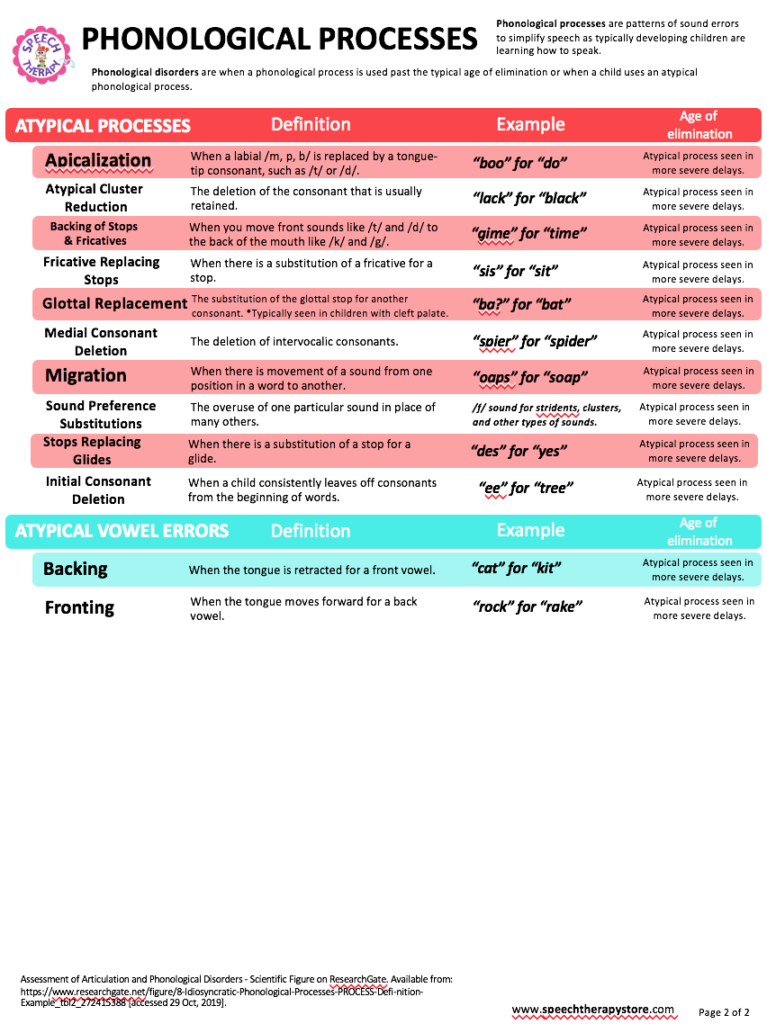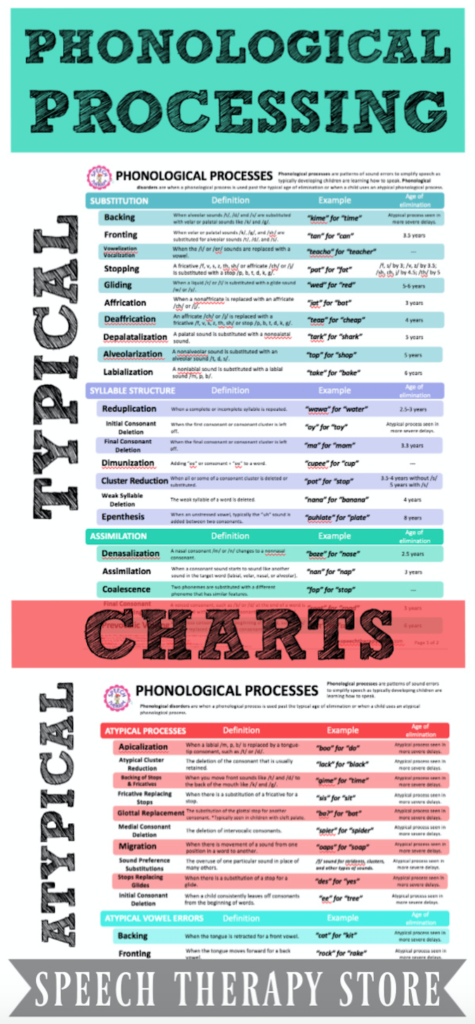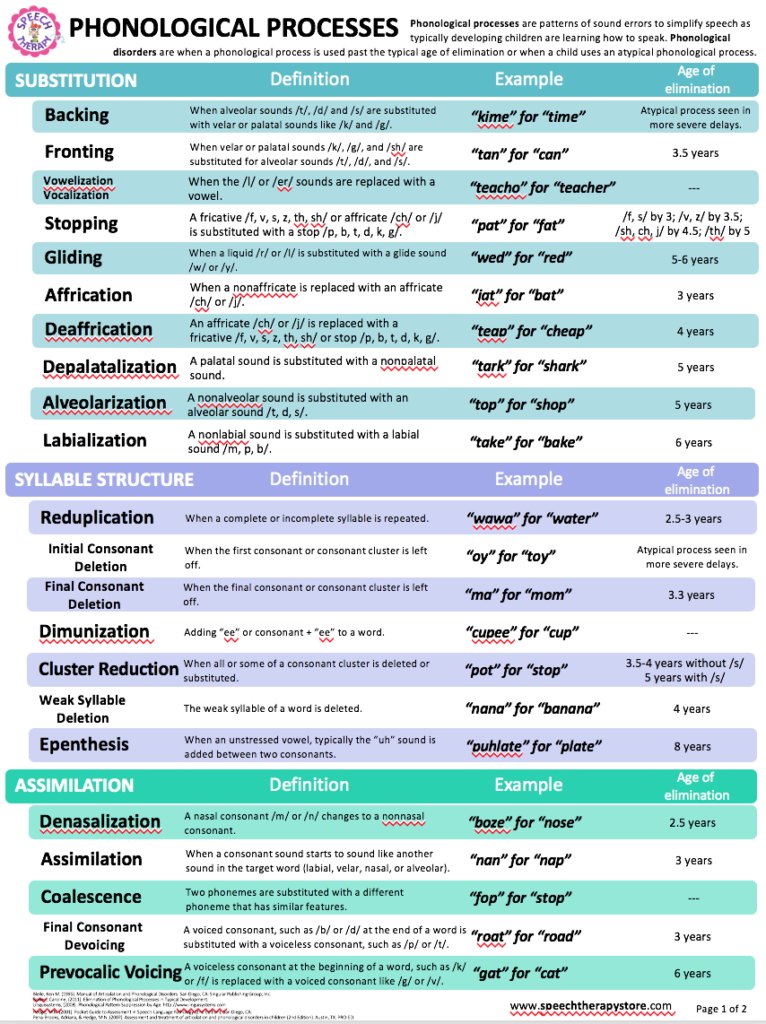Do you have a student with multiple sound errors? Are you unsure of where to start because there are so many sound errors and you have a difficult time understanding their speech? If you said yes to any of the above your student may be experiencing a phonological processing disorder.
Your student may have more than a simple articulation delay, such as struggling to produce the /r/ or /l/ sound.
They may actually have a phonological disorder which is when a student has not learned the rules for how sounds fit together in order to make words and in turn uses certain processes to simplify words.
What Are Phonological Processes?
When a child first begins to learn the language and how to speak they often use phonological processes which are patterns of sound errors to simplify speech as they are learning how to talk. Learning all of the sounds can be overwhelming for children so they simplify complex words in predictable ways to make words easier to pronounce until they can articulate correctly. These simplified speech rules are called phonological processes.
For example, the sound produced in the back on the mouth, such as /k/ and /g/ are more difficult than the sounds made in the front of the mouth, such as the /t/ and /d/ sounds. The /k/ sounds then become /t/ and the /g/ sounds then become the /d/ sound. Therefore you may hear a child say /doh/ for the word “go” or /tat/ for the word “cat”. This is an example of the phonological process called fronting.
Children aren’t aware that they are doing these phonological processes. Their brain does it simply to help them produce sounds that are difficult for them to produce.
Enjoy my Phonological Processes Chart which lists common phonological processes and the approximate age at which children should no longer be using them.
Here is a list of the typical phonological processes that we typically see children using as they learn the language. Included is a brief description, an example, along with the age of elimination.

Here is a list of the atypical phonological processes that indicate a phonological processing disorder. Included is a brief description and an example.
Are Phonological Processes Normal?
Some phonological processes are considered completely normal unless they continue to use them past the age when typically developing children stop using the phonological processes.
For example, if your 6 year old still uses the phonological process of “cluster reduction” (saying, “top” for “stop”) that would be considered delayed since most children stop using that process by the age of 5.
It is completely normal for children to use some phonological processes when they are first learning to produce speech. Here is a list of the phonological processes that are normal for children to use:
- Cluster Reduction: This is when a consonant cluster, which is two or three consonants occurring in sequence in a word (sp in spot) or (st in stop), is reduced to a single consonant through deletion. For example (pider for spider) or (top for stop).
- Reduplication: Is when all or part of a word is repeated to convey some form of meaning. For example (baba for bottle) or (wawa for water).
- Weak Syllable Deletion: This is when an unstressed or weak syllable of a multisyllabic word is deleted. For example, (nana for banana).
- Final Consonant Deletion: This is when a child omits the final consonant off of a word. For example, (ca for cat) or (ba for bat).
- Velar Fronting: This is when a child substitutes the /k/ and /g/ sounds (which are normally articulated when the tongue makes contact with the velum or soft palate at the back of the throat) with sounds that are made with the front of the tongue, the /t/ and /d/ sounds. For example, (doh for go) or (tan for can) (/t/ for /k/ and /d/ for /g/).
- Stopping: This is when a child replaces a long sounds, such as /s/ or /f/ with short sounds like /t/ or /p/). For example, (tea for see) or (pight for fight).
- Assimilation: This is when a sound is changed to be more similar to other nearby sounds. For example, (gog for dog) or (bub for bus).
When Should Phonological Processes Go Away?
The research shows that if a child does not grow out of phonological processes by certain ages than they made need speech therapy to work on them. Typically children will stop using these phonological processes on their own without any support or therapy. Here are the ages that certain commonly used phonological processes should stop being used:
Expected Age of Elimination
Assimilation ~ 3 years
Final Consonant Deletion ~ 3 years
Unstressed Syllable Deletion ~ 3 years
Reduplication ~ 3 years
Velar Fronting ~ 4 years
Stopping of Fricatives ~ 4 years
Cluster Reduction (without /s/) ~ 4 years
Cluster Reduction (with /s/) ~ 5 years
Data retrieved from Linguisystems Milestone Guide.
What are Atypical Phonological Processes?
Although most all children will use the common phonological processes there are some phonological processes that are considered abnormal. We often don’t see typically developing language speakers using these phonological processes to learn the language. If a child uses these atypical phonological processes this can be a sign that they may have a phonological processing disorder. These students should be tested by a speech-language pathologist. The following are some of the abnormal phonological processes:
- Initial Consonant Deletion: Is when a child consistently leaves off consonants from the beginning of words. For example, (ee for tree) or (ick for stick).
- Backing: This is when you move front sounds like /t/ and /d/ to the back of the mouth like /k/ and /g/, such as (kime for time) or (gime for dime).
- Apicalization: Is when a labial is replaced by a tongue-tip consonant. For example, (boo for do).
- Glottal Replacement: Is the substitution of the glottal stop for another consonant (ba? for bat). This can be seen in children with cleft palate due to difficulties with the velopharyngeal portal closure.
- Fricatives Replacing Stops: This is when there is a substitution of a fricative for a stop, such as (sis for sit) or (zoll for doll).
- Stopping of Glides: This is when there is a substitution of a stop for a glide, such as (des for yes) or (bet for wet).
- Sound Preference Substitutions: This is the overuse of one particular sound in place of many others. For example, the overuse of /f/ sound for stridents, clusters, and other types of sounds.
- Migration: Is when there is movement of a sound from one position in a word to another. For example, (oaps for soap).
- Atypical Cluster Reduction: Is the deletion of the sound that is usually retained. For example, (lay for play) or (lack for black)
- Medial Consonant Deletion: Is the deletion of intervocalic consonants, such as (spier for spider) or (cain for cabin).
- Vowel Error Patterns:
- Backing: Is when the tongue is retracted for a front vowel. For example, (cat for kit).
- Fronting: Is when the tongue moves forward for a back vowel. For example, (rock for rake).
Your Student Might Have a Phonological Processing Disorder if…
If your student uses an excessive amount of phonological processes this can be an indication of a phonological disorder because when multiple phonological processes are exhibited together it causes the child’s intelligibility to decrease. If your student is unintelligible then they will likely have a phonological delay. Their phonological skills should be assessed by a speech-language pathologist.
The standard guideline for a student’s intelligibility should be 50% intelligible by 2 years old to an unfamiliar listener. At the age of 3 years old they should be 75% intelligible to an unfamiliar listener and all students should be close to 100% intelligible by the age of 4-5 years old to an unfamiliar listener. Even if the student has a few articulation errors.
How to Treat Phonological Disorders:
If your student is using phonological processes past the age when the phonological process should diminish or if the student is using atypical processes then they likely have a phonological disorder.
Remediation for a phonological processing disorder should target the phonological processes in error as determined by the speech-language pathologist. Unlike traditional articulation therapy that targets each error sound by sound phonological disorders therapy should target eliminating the phonological processes.
In order to treat a phonological disorder, the brain needs to unlearn the rule that it has created. Here are ways to help your student fix this problem:
- Listen: First, your student needs to hear the difference between his or her errors and the correct production.
- Produce the Words: Next, the student should say the words without using the phonological process.
- Use the Word in a Sentence: Once your student can produce the word correctly then have them move on to using that word in a sentence.
- Conversation: Once your student can produce the words in sentences have them practice using the words in conversation.
- Generalization: Have the student practice correctly producing their words in everyday situations across multiple settings.
Conclusion:
A student with a phonological processing disorder has yet to learn the rules for how sounds fit together to form words and use certain processes to simplify words.
Be sure to grab your phonological processing chart freebie!
Looking for More Great Freebies?
- 430+ FREE MULTISYLLABIC WORDS LIST ACTIVITY BUNDLE
- THE ULTIMATE FREE SLP PLANNER 2020-2021 [FILLABLE]
- 71+ FREE SOCIAL PROBLEM-SOLVING SCENARIOS
- 31 BEST WORDLESS VIDEOS TO TEACH PROBLEM SOLVING
- 7+ FREE COMMUNITY OUTINGS PRINTABLES LIFE SKILLS
- 432+ FREE MEASURABLE IEP GOALS AND OBJECTIVES BANK
Reference
Assessment of Articulation and Phonological Disorders – Scientific Figure on ResearchGate. Available from: https://www.researchgate.net/figure/8-Idiosyncratic-Phonological-Processes-PROCESS-Defi-nition-Example_tbl2_272415388 [accessed 27 Oct, 2019]
Bauman-Waengler, J. A. (2012). Articulatory and phonological impairments. New York, NY: Pearson Higher Education.
Bernthal, J., Bankson, N. W., & Flipsen, P., Jr. (2013). Articulation and phonological disorders. New York, NY: Pearson Higher Education.
Bleile, Ken M. (1995). Manual of Articulation and Phonological Disorders. San Diego, CA: Singular Publishing Group, Inc.
Bowen, Caroline, (2011). Elimination of Phonological Processes in Typical Development.
Linguisystems, (2008). Phonological Pattern Suppression by Age. http://www.linguisystems.com
Hedge, M.N. (2001). Pocket Guide to Assessment in Speech-Language Pathology (2nd Edition). San Diego, CA:
Pena-Brooks, Adriana, & Hedge, M.N. (2007). Assessment and treatment of articulation and phonological disorders in children (2nd Edition). Austin, TX: PRO-ED.
Shipley, K. G., & McAfee, J. G. (2016). Assessment in speech-language pathology: A resource manual. Boston, MA: Cengage Learning.
Wagner, R. K., & Torgesen, J. K. (1987). The nature of phonological processing and its causal role in the acquisition of reading skills. Psychological Bulletin, 101, 192-212.



Irina
Sunday 13th of February 2022
I filled out the link but didn't get the processes sent to my email. I'd love the chart, please!
Melissa Berg
Monday 14th of February 2022
Hi Irina, I sent you an email with the chart that you were looking for. Thanks for reaching out!
Stopping Phonological Process: What is it? [Free Worksheets] - Speech Therapy Store
Sunday 1st of December 2019
[…] structure. Want to know more about these three categories? Be sure to learn about all of the typical and atypical phonological processes and don’t forget to download the handy […]